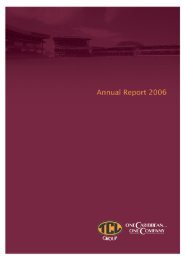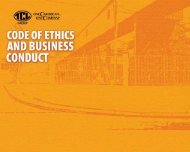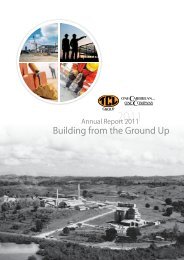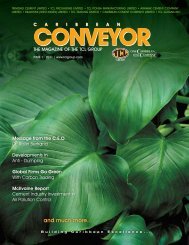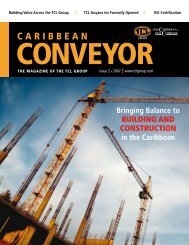Download File - TCL Group
Download File - TCL Group
Download File - TCL Group
You also want an ePaper? Increase the reach of your titles
YUMPU automatically turns print PDFs into web optimized ePapers that Google loves.
NOTES TO THE CONSOLIDATED FINANCIAL STATEMENTS<br />
FOR THE YEAR ENDED 31ST DECEMBER, 2010<br />
(Expressed in Thousands of Trinidad and Tobago Dollars, except where otherwise stated)<br />
(Continued)<br />
2. Significant accounting policies (continued)<br />
d) Business combinations and goodwill<br />
Business combinations from 1 January 2010<br />
Business combinations are accounted for using the acquisition method. The cost of an acquisition is measured as the aggregate of the<br />
consideration transferred, measured at acquisition date fair value and the amount of any non-controlling interest in the acquiree. For<br />
each business combination, the acquirer measures the non-controlling interest in the acquiree either at fair value or at the proportionate<br />
share of the acquiree’s identifiable net assets. Acquisition costs incurred are expensed and included in administrative expenses.<br />
When the <strong>Group</strong> acquires a business, it assesses the financial assets and liabilities assumed for appropriate classification and designation<br />
in accordance with the contractual terms, economic circumstances and pertinent conditions as at the acquisition date. This includes the<br />
separation of embedded derivatives in host contracts by the acquiree.<br />
If the business combination is achieved in stages, the acquisition date fair value of the acquirer’s previously held equity interest in the<br />
acquiree is remeasured to fair value at the acquisition date through the consolidated income statement.<br />
Any contingent consideration to be transferred by the acquirer will be recognized at fair value at the acquisition date. Subsequent<br />
changes to the fair value of the contingent consideration which is deemed to be an asset or liability, will be recognized in accordance<br />
with IAS 39 either in the consolidated income statement or as a change to other comprehensive income. If the contingent consideration<br />
is classified as equity, it should not be remeasured until it is finally settled within equity.<br />
Goodwill is initially measured at cost being the excess of the aggregate of the consideration transferred and the amount recognized<br />
for non-controlling interest over the net identifiable assets acquired and liabilities assumed. If this consideration is lower than the fair<br />
value of the net assets of the subsidiary acquired, the difference is recognized in consolidated statement of income.<br />
After initial recognition, goodwill is measured at cost less any accumulated impairment losses. For the purpose of impairment testing,<br />
goodwill acquired in a business combination is, from the acquisition date, allocated each of the <strong>Group</strong>’s cash-generating units that<br />
are expected to benefit from the combination, irrespective of whether other assets or liabilities of the acquiree are assigned to those<br />
units.<br />
Where goodwill forms part of a cash-generating unit and part of the operation within that unit is disposed of, the goodwill associated<br />
with the operation disposed of is included in the carrying amount of the operation when determining the gain or loss on disposal of<br />
the operation. Goodwill disposed of in this circumstance is measured based on the relative values of the operation disposed of and the<br />
portion of the cash-generating unit retained.<br />
Business combinations prior to 1 January 2010<br />
In comparison to the above-mentioned requirements, the following differences applied:<br />
Business combinations were accounted for using the purchase method. Transaction costs directly attributable to the acquisition formed<br />
part of the acquisition costs. The non-controlling interest (formerly known as minority interest) was measured at the proportionate<br />
share of the acquiree’s identifiable net assets.<br />
Business combinations achieved in stages were accounted for as separate steps. Any additional acquired share of interest did not affect<br />
previously recognized goodwill.<br />
When the <strong>Group</strong> acquired a business, embedded derivatives separated from the host contract by the acquiree were not reassessed on<br />
acquisition unless the business combination resulted in a change in the terms of the contract that significantly modified the cash flows<br />
that otherwise would have been required under the contract.<br />
Contingent consideration was recognized if, and only if, the <strong>Group</strong> had a present obligation, the economic outflow was more likely<br />
than not and a reliable estimate was determinable. Subsequent adjustments to the contingent consideration were recognized as part<br />
of the goodwill.<br />
19<br />
BUILD TO LAST FOR GENERATIONS



